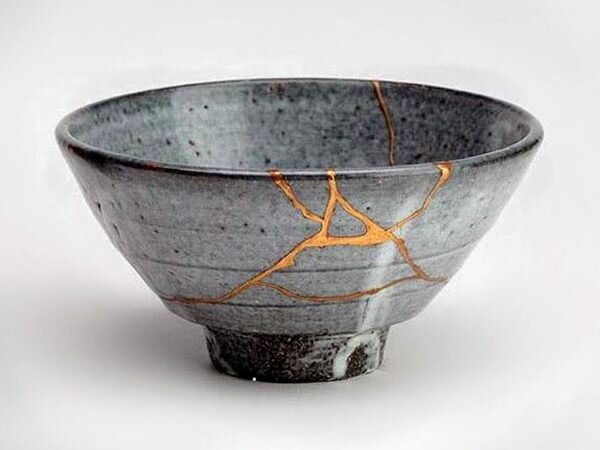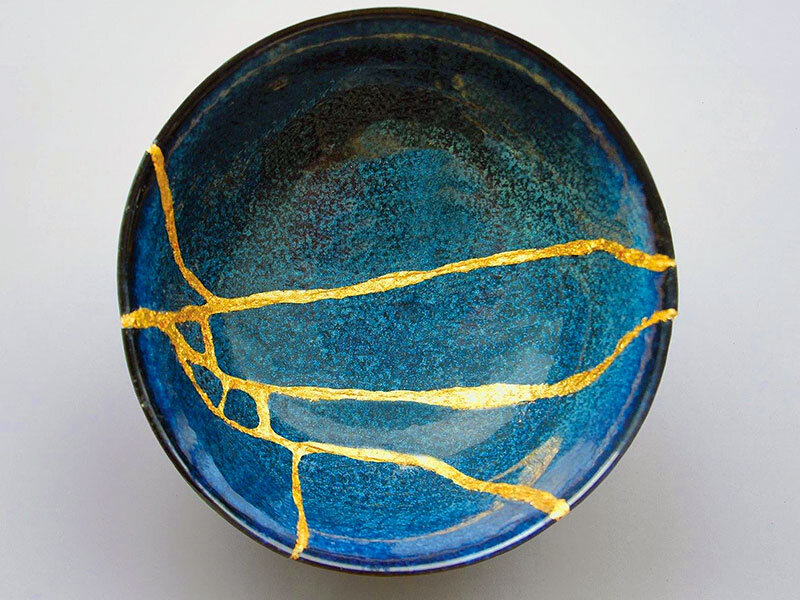Lately I’ve been fascinated with Kintsugi, which is the Japanese art of repairing broken pottery. In this process, pieces of broken pottery are painstakingly joined back together using a lacquer that is mixed with gold, silver, or platinum. When the process is finished the resulting piece is more unique and usually more valuable than the original. Here is a look at a few pieces of Kintsugi pottery:
Kintsugi is related to the Japanese philosophy of Wabi-sabi, the aesthetic tradition of embracing the beauty found in imperfections. According to Richard Powell, “Wabi-sabi nurtures all that is authentic by acknowledging three realities: nothing lasts, nothing is finished, and nothing is perfect.”* These three principles have their origins in the Buddhist concept of the three marks of existence.
It makes sense that Kintsugi is related to a larger philosophical framework because this process of repair can be a powerful metaphor for human situations we encounter all the time. For example, a long-term relationship will inevitably develop cracks or breaks over time. Are we content to throw those relationships away, or to repair them with scotch tape or cheap glue? Or should we instead give those cracks and breaks our time and attention, repairing them with as much care as possible? If we do, the resulting relationship looks different, but it can be more unique, more beautiful, and longer-lasting because of those repairs.
We can view ourselves individually through the same metaphorical lens. In this case, I will focus on applying the metaphor of Kintsugi to the practice of music. There are four main principles that we can take from Kintsugi directly into the practice room:
1. Don’t throw it away
Anyone who is reading this has probably already been tempted to give up on a piece of music, a skill, or even on the study of music itself. The foundational principle of Kintsugi is to honor and value something that appears broken. Since we don’t all start out with the same teacup or vase, this could mean a variety of things to any given musician. But one important concept to remember is that whatever may be broken is rarely completely irreparable. If we make the conscious decision to repair or rebuild some aspect of our playing in the practice room, that time and attention will be well spent.
2. Embrace imperfections
In the modern musical world, perfection is almost a requirement. This especially applies to recorded music, which is usually engineered to sound completely flawless. It is an impossibly high standard, and one that makes us hyper aware of our own flaws. But the imperfections in our playing are incredibly important, because on the other side of each of our weaknesses is a strength. As a college student I longed for each note attack to sound robotically “perfect.” It took me years to realize that the flip side of that imperfection was my unique musical approach. I’m good at exaggerating musical gestures and phrasing, but the price is that I sometimes take too big of a swing. Although I still practice for consistency, I try to preserve my expressive musical language while doing so. Embracing our weaknesses doesn’t necessarily mean not working on them–it means accepting and striving to maintain whatever makes us ourselves as we improve.
3. Turn weaknesses into strengths
This idea is one that I try to implement in a very specific and literal way in the practice room. Rather than simply glueing and painting over the cracks in a piece of pottery in an effort to make them invisible, practitioners of Kintsugi emphasize those lines with gold. The areas that were originally weak become the highlight of the piece.
When learning a piece of music there will always be passages that are more difficult to put together than others. Instead of simply trying to survive those moments, I challenge myself to turn them into areas of strength. I will memorize them, play them slowly with metronome and tuner, and generally get to know them inside out and upside down. The goal is to reach a point where those tricky areas are not only passable, but are actually the most comfortable and polished moments in the piece. That is easer said than done, of course, but even just aspiring to that level of mastery helps make my practice more focused and productive.
4. Create a unique finished product
Part of what makes Kintsugi pottery so valuable is the fact that no two pieces are alike. Individuality should also be a main goal of our musical development. Audiences have often valued stylistic and musical uniqueness over technical perfection (even if our conservatory training instilled in us the opposite impression). But individuality also extends to what we choose to do. Many musicians are finding that creating their own specialty and following a unique path allows for a more personalized, less “cookie-cutter” experience. In this way, like Kintsugi, value comes from what is uniquely our own instead of the elements we share with everyone else.
Mindfulness is all about deciding where and how we direct our attention and focus. I often enter into a practice session with the goal of fixing something specific. But reimagining my approach using the metaphor of Kintsugi has given me a different perspective on mistakes, imperfections, and on my own individuality as a musician. I like the idea that the painstaking work we do is not to make us like everyone else, but is instead to make us more ourselves. Which is good because that work continues … forever!
* Powell, Richard R. (2004). Wabi Sabi Simple. Adams Media.

